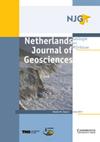在类型区(荷兰东南部,比利时东北部)以生物碎屑为基础的马斯特里赫特天文时间标度及其地层意义:P.J. Felder的遗产
IF 2.3
2区 地球科学
Q3 GEOSCIENCES, MULTIDISCIPLINARY
Netherlands Journal of Geosciences-Geologie En Mijnbouw
Pub Date : 2018-11-23
DOI:10.1017/njg.2018.15
引用次数: 16
摘要
本文致力于纪念2009年去世的当地地质工程师Peter Jozef (Sjeuf) Felder的遗产,证实了他的观点,即生物碎屑构成了马斯特里赫特附近马斯特里赫特阶段类型区域的地表和钻孔岩心对比的宝贵工具。他将生物碎屑含量的变化解释为受米兰科维奇旋回的影响,这种方法已经成功地应用于研究地区马斯特里赫特(白垩纪晚期)的整个沉积复合体。在目前的方法中,结果得到了指数化石的证实,主要是鞭毛藻囊肿,但也有钙质纳米化石,这些化石可以与丹麦东部的stevens -1岩心参考剖面进行对比。除了局部残存的Belemnella obtusa带年龄外,其类型区内的Maastrichtian阶段包括白垩纪最后4.6 Ma(即Belemnella sumensis/Acanthoscaphites tridens带至K/Pg边界)。P.J. Felder的生物碎屑分析已经在该地区发现了12个400 kyr的米兰科维奇旋回偏心旋回。然而,截面不是连续的;在enci - heidelberg水泥集团采石场的Gulpen和Maastricht地层之间有一个大约700公里的间隙。此外,在上马斯特里赫特组中还发现了较小的断裂,通常在几个20kyr旋回的范围内。本文章由计算机程序翻译,如有差异,请以英文原文为准。
A bioclast-based astronomical timescale for the Maastrichtian in the type area (southeast Netherlands, northeast Belgium) and stratigraphic implications: the legacy of P.J. Felder
Abstract The present paper, dedicated to the legacy of local geologist–engineer Peter Jozef (Sjeuf) Felder, who died in 2009, confirms his view that bioclasts constitute a valuable tool in the correlation of outcrops and borehole cores across the type area of the Maastrichtian Stage in the vicinity of Maastricht. His approach of interpreting changes in bioclast contents as having been influenced by Milankovitch cyclicity has here been applied successfully to the entire sedimentary complex of Maastrichtian (latest Cretaceous) age in the study area. In the present approach, results are corroborated by index fossils, mainly dinoflagellate cysts but also calcareous nannofossils, which allow correlation with the Stevns-1 core reference section in eastern Denmark. With the exception of local remnants of Belemnella obtusa Zone age, the Maastrichtian Stage in its type area encompasses the last 4.6 Ma of the Cretaceous Period (i.e. the Belemnella sumensis/Acanthoscaphites tridens Zone up to the K/Pg boundary). P.J. Felder's bioclast analyses have enabled the detection of twelve 400 kyr eccentricity cycles of Milankovitch cyclicity in the area. However, the section is not continuous; there is a hiatus of c.700 kyr between the Gulpen and Maastricht formations at the ENCI-HeidelbergCement Group quarry. In addition, smaller hiatuses, usually in the range of several 20 kyr cycles, have been detected in the upper Maastricht Formation.
求助全文
通过发布文献求助,成功后即可免费获取论文全文。
去求助
来源期刊
CiteScore
4.00
自引率
25.90%
发文量
14
审稿时长
>12 weeks
期刊介绍:
Netherlands Journal of Geosciences - Geologie en Mijnbouw is a fully open access journal which publishes papers on all aspects of geoscience, providing they are of international interest and quality. As the official publication of the ''Netherlands Journal of Geosciences'' Foundation the journal publishes new and significant research in geosciences with a regional focus on the Netherlands, the North Sea region and relevant adjacent areas. A wide range of topics within the geosciences are covered in the journal, including "geology, physical geography, geophyics, (geo-)archeology, paleontology, hydro(geo)logy, hydrocarbon exploration, modelling and visualisation."
The journal is a continuation of Geologie and Mijnbouw (published by the Royal Geological and Mining Society of the Netherlands, KNGMG) and Mededelingen Nederlands Instituut voor Toegepaste Geowetenschappen (published by TNO Geological Survey of the Netherlands). The journal is published in full colour.

 求助内容:
求助内容: 应助结果提醒方式:
应助结果提醒方式:


